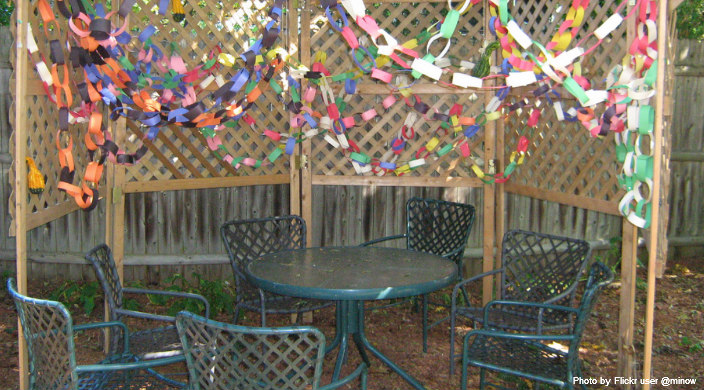
Sukkot can be the ideal Jewish holiday for disability inclusion. OK, every holiday should be inclusive – but certain holidays lend themselves more naturally toward being inclusive than others. I think it wise to learn what we can and apply that wisdom across other situations as we strive to make every holiday inclusive.
What is Sukkot?
“On the fifteenth day of this seventh month there shall be the Feast of Booths to the Eternal, [to last] seven days.” –Leviticus 23:34
Sukkot is a Pilgrimage Festival in which Jews celebrate the autumn harvest. The Torah identifies the sukkah (booth) with the temporary dwellings in which the Israelites lived during their journey through the wilderness to Israel. The mood of Sukkot is joyous. The symbolism of a successful harvest offers a welcome change of pace from Rosh Hashanah and Yom Kippur; which were much more solemn days of prayer and introspection.
Sukkot is inherently multisensory.
Sukkot is a holiday that is celebrated outdoors, allowing us to feast our senses on the sights, sounds and smells of nature. The roofs of our sukkot (temporary dwellings) must allow the sky to be visible, offering an added visual experience. We eat our meals in the sukkah – and what turkey sandwich doesn’t taste a little better when sitting outdoors on a gorgeous fall day? We appreciate the unique textures of the lulav and etrog as we hold them, and we enjoy physical movement as we shake the lulav in every direction (symbolizing that God is everywhere). Finally, we smell the delightful aromas of palm, willow and myrtle in our lulav and lightly scratch the surface of the etrog, drawing in delicious scents that engage our senses even more.
Decorating the sukkah is a hands-on experience.
Hands-on activities are wonderful, inclusive opportunities. Rather than simply being a holiday that focuses on intellectual discourse, Sukkot affords us with the chance to engage individuals of varying ages and abilities. Everyone can contribute something of value and significance in making our sukkah more inviting and beautiful.
Each sukkah must only have three sides.
The sukkah’s design is intended to be only three sides, leaving one wall completely open. This is specifically designed as a way to welcome guests, and nothing lends itself better to inclusion than a nonexistent wall symbolizing a “Hey, come on in!” attitude. What’s more, the wide opening may help to make your sukkah wheelchair accessible.
The celebration of Sukkot is a whole week long.
This is great if the weather doesn’t cooperate, but it’s even better for inclusion. Nothing feels worse than having to cancel on a holiday celebration due to a health concern or after a child’s meltdown or just because of a tough day, while thinking you’ll have to wait a whole year before you can try again. Multiple opportunities for celebration are always more inclusive.
Simply being in the sukkah is a mitzvah.
When all else fails, simply spending time in the sukkah fulfills the mitzvah (commandment) of celebrating the holiday. Even if someone is unable to mark the holiday in any other way, simply being in the sukkah for any length of time will suffice.
How do you ensure your holiday celebrations are inclusive?
Related Posts

In Search of Belonging in the Darkness, the Twilight, and the Light

The Art of Wisdom: Proverbs, Adages, and Maxims, and the Images They Inspire

